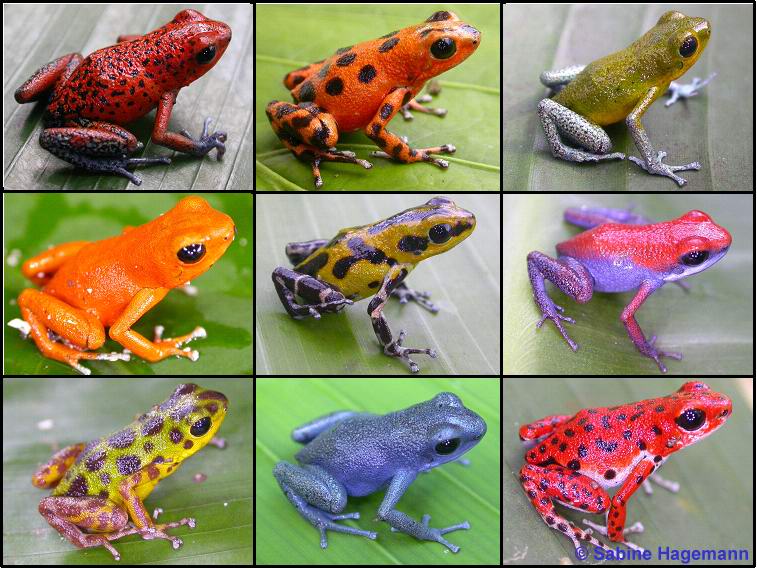捕食者的篩選如何影響草莓箭毒蛙的不同族群的警戒色
 |
| photo from Bgreenproject |
摘要
Natural selection is widely noted to drive divergence of phenotypic traits. Predation pressure can facilitate morphological divergence, for example the evolution of both cryptic and conspicuous coloration in animals. In this context Dendrobatid frogs have been used to study evolutionary forces inducing diversity in protective coloration. The polytypic straw- berry poison frog (Oophaga pumilio) shows strong divergence in aposematic coloration among populations. To investigate whether predation pressure is important for color divergence among populations of O. pumilio we selected four mainland populations and two island populations from Costa Rica and Panama. Spectrometric measurements of body coloration were used to calculate color and brightness contrasts of frogs as an indicator of conspicuousness for the visual systems of several potential predators (avian, crab and snake) and a conspecific observer. Additionally, we conducted experiments using clay model frogs of different coloration to investigate whether the local coloration of frogs is better protected than non-local color morphs, and if predator communities vary among populations. Overall predation risk differed strongly among populations and interestingly was higher on the two island populations. Imprints on clay models indicated that birds are the main predators while attacks of other predators were rare. Furthermore, clay models of local coloration were equally likely to be attacked as those of non-local coloration. Overall conspicuousness (and brightness contrast) of local frogs was positively correlated with attack rates by birds across populations. Together with results from earlier studies we conclude that conspicuousness honestly indicates toxicity to avian predators. The different coloration patterns among populations of strawberry poison frogs in combination with behavior and toxicity might integrate into equally efficient anti-predator strategies depending on local predation and other ecological factors.
草莓箭毒蛙(Oophaga pumilio)是個不同族群長的不一樣的多態性物種,而且每個族群呈現不同的警戒性。這樣的現象通常引起科學家的興趣,因為這可能代表背後不同的選汰力量,也牽涉到潛在的種化趨勢,這些難解的問題到底來自天擇,還是來自性擇,還是來自其他未知的力量?
| 不同族群在不同視覺模型下的相對亮度與相對顏色 photo from Fig. 1 |
| 不同族群的被攻擊數,灰色來自鳥類,黑色來自其他攻擊 photo from Fig. 2 |
| 綜合6個族群,不同顏色的被攻擊數 photo from Fig. 3 |
反射光譜的部分各有千秋,細節詳見內文。整體來說背部紅/橘與黃色的族群的顯眼度整體高於藍色與綠色,腹部的顯眼度基本上沒有差異,但Isla Colon的腹部黃色比起Isla Solarte的顯眼度差不多或稍高。捕食實驗的結果每個族群各有差異,兩個島嶼族群的被攻擊數比較高,然而如同當地顏色的黏土模型的被攻擊數與非當地顏色的沒有差異。整體來說大部分的攻擊都來自鳥類,來自其他的攻擊顯著的比起鳥類少很多。綜合這個研究與之前的研究,不同顏色的不同族群忠實的反應其毒性。儘管毒性有所不同,但配合不同的行為調整,可能可以讓不同族群的防禦效益,讓族群間的「防禦值」達到同樣的水準,反應不同的捕食壓力與其他的生態因子。
這個文章整體看起來,捕食者對多態型的形成主要的壓力是來自鳥類,然而細緻的型態演化本篇沒有多著墨,大概還是跟不同種的鳥類認知與細膩的演化有關。總和近期的文章來看,捕食者到底認得什麼似乎是個重要的關鍵,或許這些作者可以考慮使用3D列印,真正印出類似的斑紋,替代單純的只使用顏色分類的模型,可能可以比較反應真實的情況。





0 comments